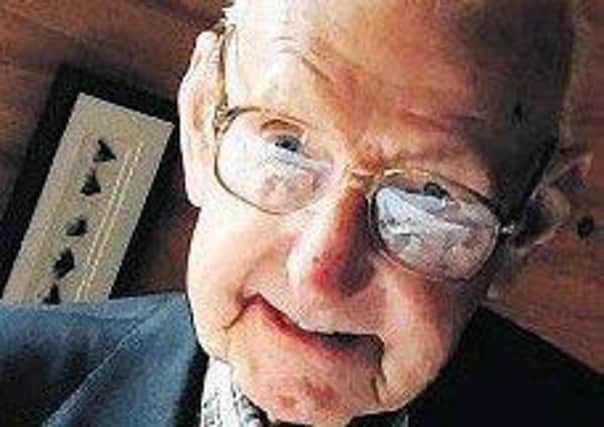Obituary: Charles Mackie Forbes, lorry driver and soldier


Like so many of his generation Charlie Forbes never really spoke of his war. But last August, on the 75th anniversary of the night his troopship sank, he broke his silence about the deadly German torpedo attack. “I was lying in the North Atlantic, not knowing whether I was going to live or die,” he mentioned casually to his son Ian.
Then a 25-year-old lorry driver, married and the father of two young boys, he endured several hours in the water after the attack on the SS Mohamed Ali El-Kebir, which claimed the lives of almost 100 men and wounded many of his colleagues.
Advertisement
Hide AdAdvertisement
Hide AdBut survive he did and, after being picked up by HMS Griffin and taken back to Greenock, he went on to spend another five long years in the army before returning to Aberdeenshire, where he was the last surviving member of 706 Artisan Works Company, Royal Engineers, until his death on his 101st birthday.
The eldest of nine children, he was the son of a Deeside gamekeeper and was born at Green Cottage, Raemoir, near Banchory, during the Great War, just a few weeks before the second Battle of Ypres.
He started school in the village of Dunecht in 1920 before the family moved a little further to Fintray, where he finished his education at the local village school and began working on farms. In 1934, in his late teens, he moved back nearer to Banchory, to Lumphanan, where he met Flossie, whom he married the following year.
For the next four years he worked with Aberdeenshire County Council’s roads department before signing up for the army soon after the start of the Second World War – but only after gaining assurances from his boss that he would still have his council job to come back to.
Part of a volunteer force of the Royal Engineers construction group, he served in France where the company was attached to the RAF and worked on airfields and gun emplacements. Fortunately, Forbes got out of France just before the evacuation of Dunkirk, a massive operation, in the early summer of 1940, to rescue hundreds of retreating Allied troops of the British Expeditionary Force trapped on the beaches by the Germany Army.
However, a couple of months later he was en route to Gibraltar, one of more than 700 soldiers plus approximately 160 crew, on board the requisitioned Egyptian liner the SS Mohamed Ali El-Kebir, when the commander of U-boat 38, Kapitanleutnant Heinrich Liebe, unexpectedly got them in his sights off the west coast of Ireland.
The troopship, which was also carrying military stores, was just two days into the voyage, sailing with the destroyer HMS Griffin as an escort, and following a zig-zag course to try to dodge any enemy submarines. When Liebe surfaced at 9pm on 7 August, 1940, he admitted he was taken by surprise when he spotted the steamer eight or nine kilometres ahead, a fact he noted in his war diary.
However, 45 minutes later he had moved stealthily to within just one kilometre of the vessel and unleashed a torpedo spread.
Advertisement
Hide AdAdvertisement
Hide AdThe Mohamed Ali El-Kebir took a direct hit from one underwater missile, which took out two bulkheads, and the captain gave the order to man the lifeboats. Forbes had been on guard duty at the time and was among the hundreds, many only wearing trousers and singlets, who abandoned the ship, taking their life in their hands in the heavy swell. A number had been injured in the explosion and the ship’s doctor and medical officer heroically tended to the casualties. Knowing the ship could sink at any minute they worked on, dressing the wounds of the injured before lowering them on stretchers into the lifeboats and rafts.
In the event the vessel did not go down for nearly two hours, but the sea state hampered rescue efforts and left the survivors at the mercy of the ocean for up to seven hours. The last of them was reportedly picked up at 5 o’clock the morning after the torpedo attack on the former liner, the ship on which King Farouk of Egypt and his first wife were said to have spent some of their honeymoon.
Among the missing were the captain and the ship’s doctor but a total of 766 survivors, including Forbes, were landed at Greenock on 9 August. He was then posted to RAF Biggin Hill, which at the time was being targeted by German bombers during the Battle of Britain, and spent a period in the London area before being sent to North Africa in 1943, where the company carried out various construction works. From there he went to Italy, where he spent 18 months, and he ended his army career with six months in Austria before being demobbed and returning to Aberdeenshire Council.
Back home he retained his connection with the forces, as standard bearer for the Lumphanan British Legion for 45 years, and he was made an honorary member a few years ago. He was also the Legion’s poppy convenor, a role he maintained well into his nineties, and had been treasurer of his local senior citizens’ club.
He celebrated his 100th birthday last year with a gathering for family and friends near his home in Aboyne where he has lived for the last 20 years.
His son Ian said: “Even in the last year he still managed on his own. He truly lived his life and every one of his 101 years to the full – not many 77-year-olds can say they still had their father.
“He was also able to know his grandchildren, great-grandchildren and great-great-grandchildren and that really is an achievement in itself. To live that long is quite remarkable.”
Predeceased by his wife and their elder son Charles Jr, he is survived by his son Ian, brothers William and Douglas and large extended family.